What’s a Good Conversion Rate for eCommerce?
If you’re looking to improve your eCommerce conversion rate and are looking for evidence of what makes a good conversion rate for eCommerce, we’ve reviewed our historic data and spoken to our conversion rate optimisation agency partners to curate all the latest research into one place.
Your eCommerce conversion rate is going to be significantly improved if you have a large proportion of returning visitors, versus new ones
In a nutshell, the average UK eCommerce conversion rate is around 2% so if your sitewide eCommerce conversion rate is above that, that would be good right? Well maybe on the initial face of it.
However, to best answer the question, it really depends on the circumstances of your website – which countries you operate in, what marketing channels you use and how big your brand is to fairly judge how your eCommerce conversion rate really compares.

But first, let’s clarify exactly what we mean by eCommerce conversion rate.
What is an eCommerce conversion rate?
An eCommerce conversion rate is a percentage represented by dividing the total number of online sales by the total number of website visits.
How do I calculate my eCommerce conversion rate?
To work out your eCommerce conversion rate % using Google Analytics data, you need to divide the total number of transactions by the total number of sessions, then multiply by 100.
eCommerce Conversion Rate % = Total Number of Transactions / Total Number of Sessions * 100
If you enable Google Analytics eCommerce Tracking and cross reference with your back-end sales data to make sure there is a match, Google Analytics will deliver you your eCommerce conversion rate automatically across all your reports.
Example eCommerce conversion rate by traffic channel report in Google Analytics
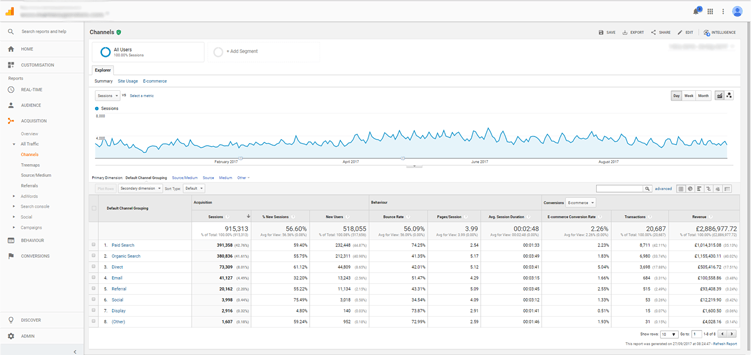
eCommerce conversion rate by audience type
First things first, your eCommerce conversion rate is going to be significantly improved if you have a large proportion of returning visitors, versus new ones.
This means if you are an established brand, with thousands of existing customers who regularly buy from you, your eCommerce conversion rate should be above average.
If you’re a retailer turning over less than £1 million online, then you’ll be more likely to have a very high proportion of new visitors and therefore your average eCommerce conversion rate is more likely to be below the average.
The eCommerce Benchmarking Study by Marketing Sherpa 2016, found that the large majority (40%) of the 4000+ companies using Magento that they surveyed had eCommerce conversion rates of between 1 - 5%. Around a fifth (17%) had an eCommerce conversion rate of less than 1%.
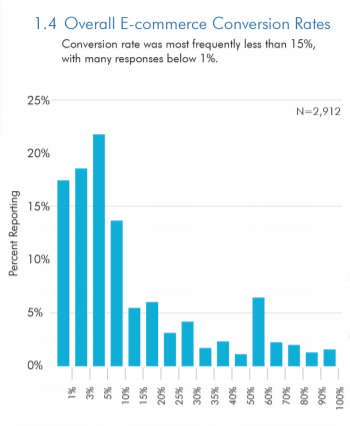
eCommerce conversion rate by country
Where your customers come from is another factor in what your eCommerce conversion rate may be. For example, the eCommerce Foundation Report found that Germany came top of the list with an eCommerce conversion rate of 2.22%, the United States came second with 1.96% and the UK third with 1.88%. So the more international your customers, the more that will impact your conversion rate.
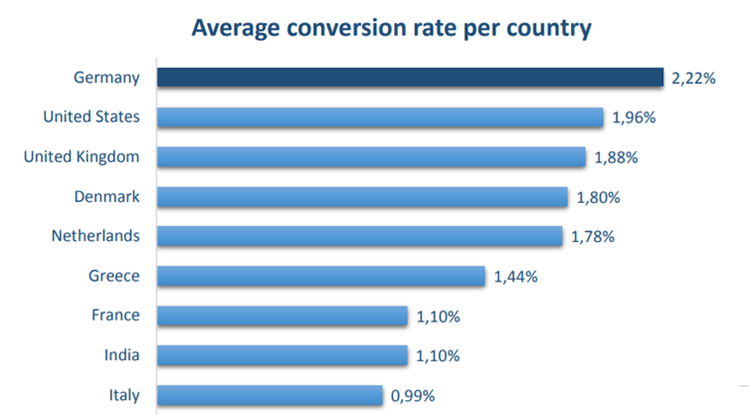
eCommerce conversion rate by device
As the prevalence of shoppers armed with smartphones has increased so has the complexity of the buying journey, with buyers frequently researching on their phones to later convert on a desktop. If the products you sell, lend themselves well to browsing whilst on the bus, then don’t be surprised that you get a lot of traffic from mobiles but it converts at a lower conversion rate than purchases via a desktop.
Monetate’s eCommerce Benchmark Study of over 2.5 million websites, shows that in the UK in Q4 2016 (more on seasonality later), the average conversion rate by a traditional device such as laptop or PC was a whopping 4.14%, tablet users weren’t too far behind at 3.56%, whereas the average smartphone conversion rate was just 1.55%.
Following on from the very first point on returning visitors versus new visitors, if you have a good volume of traffic from mobiles, your desktop channels will more likely contain a high proportion of returning visitors that have been browsing on other devices, however as far as your last click Google Analytics data is concerned are recorded as brand new visitors. Your overall conversion rate may well go down if you improve your mobile experience. But as long as the total traffic, orders, revenue and profit are all going in the right direction, you now have more people finding and buying from your site than before. So that’s awesome!
eCommerce conversion rate by sector
As I touched upon in the last point, if your products require a greater investment such as within the travel and luxury sectors. Or your products aren’t impulse buys and need to be researched online and instore, such as within the furniture retail sector then that will reduce your eCommerce conversion rate.
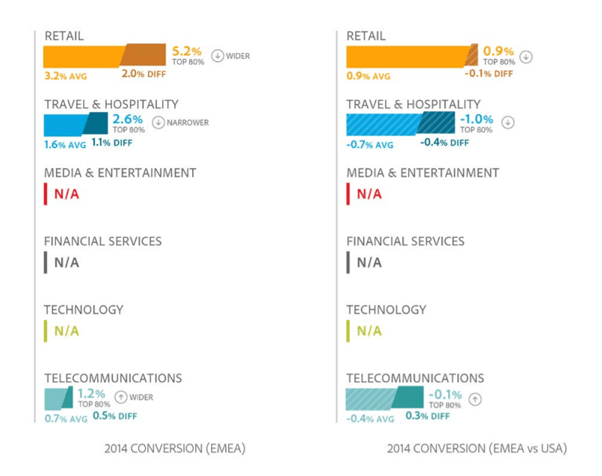
eCommerce conversion rate by channel
Your digital marketing channel mix will also massively impact your overall eCommerce conversion rate. If you have an established Google AdWords campaign where you’ve continuously improved your return on ad spend, then you know what keywords convert and your Paid Search conversion rate could well be between 2 – 5% or more.
If you’ve invested in long term Organic Search then your conversion rates from that channel could easily be 2 – 3% when using Google’s last click attribution model alone.
Again, the more brand awareness activities you run, such as Content Marketing, Blogging, Digital PR, Digital Advertising and Social Advertising, the lower your likely conversion rates will be from those channels as they contain more new visitors.
But don’t forget, you want new visitors as they turn into existing customers who are significantly more likely to convert. So your Direct and Email channels are absolutely essential and should be your top converting channels as these contain a far higher number of returning visitors.
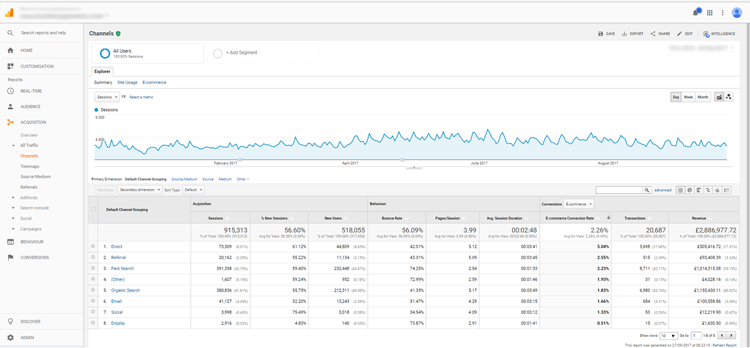
Source: Google Analytics Acquisition Traffic Report
eCommerce conversion rate by time
Not forgetting that time will also impact your eCommerce conversion rate.

Time of year
If you launch your new site in the run up to Christmas, don’t expect your eCommerce conversion rate to stay at those lofty heights throughout the year. We’ve seen average eCommerce conversion rates regularly hit 3 – 5% at Christmas time, when the usual average is 1 – 2%.
Time of day
Do get very excited about learning what times of day your best customers buy at however, as this is a dimension you can optimise your paid advertising budget for all year round.
Our eCommerce conversion analysis has revealed that for a number of our eCommerce clients, consumers browse during the day but buy when they get home from work, so we make sure we pace the media spend to bid aggressively at the peak evening hours. Rather than exhausting all our budget by the best converting time by leaving our campaigns on Google’s default settings.
For other clients, peak purchasing might happen between Saturday morning to Sunday night so incorporating weekend-related copy into the ad creative further increases engagement and overall eCommerce conversion rate.
eCommerce conversion rate conclusion
So in summary, a good eCommerce conversion rate really depends on where you are and may not be the best metric to focus on at all. Especially, if you're increasing investment in acquisition marketing channels like PPC, SEO and Social Advertising, launching a new mobile optimised site or you're in your peak trading period.
For more eCommerce marketing insights join the ThoughtShift Guest List and get the latest blogs delivered to your inbox each month or ask us for a free eCommerce marketing analysis of your website and the best metrics we'd recommend for you to measure your success.

